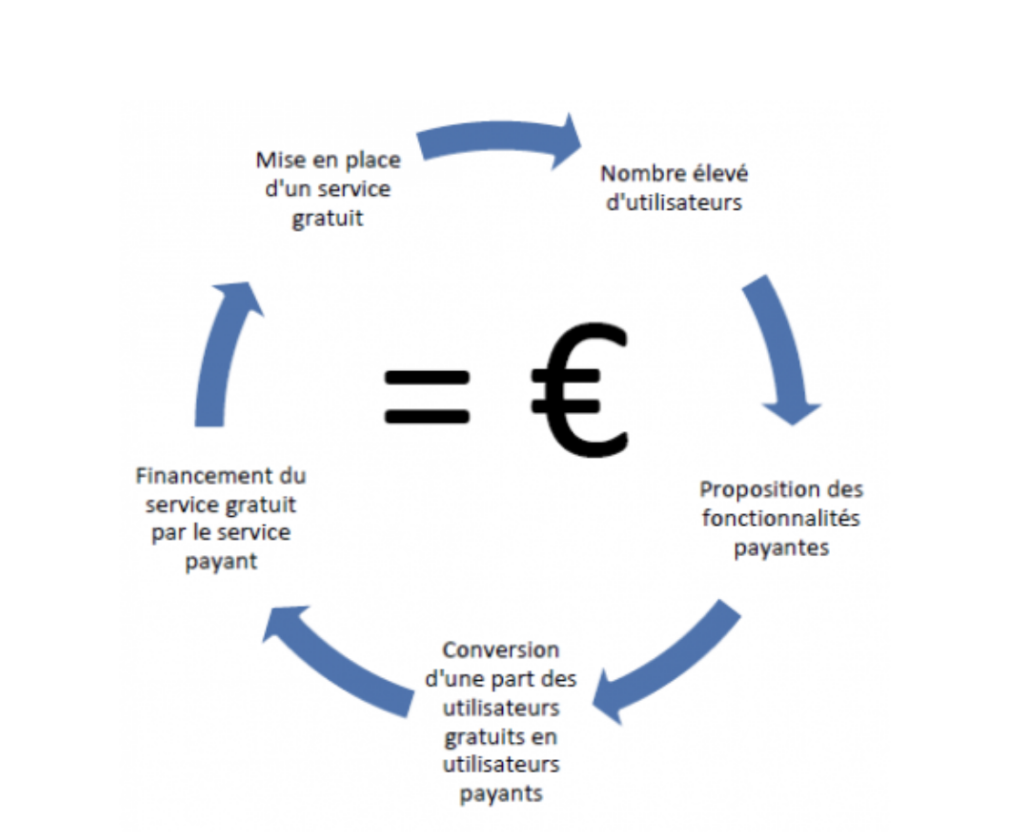This article is part of our series on subscription strategies, whether you’re looking to launch your subscription offer or optimize an existing one. 😃
This series covers all aspects of the topic: acquisition, conversion, customer retention, and KPIs.
“Pairing a free offer with paid features”, that’s the essence of the freemium model.
This approach can quickly expand your user base, but not without careful planning.
Succeeding with this model requires a meticulous strategy to convert initial interest into sustained engagement and stable revenue.
So, is it really a miracle solution or just an alluring illusion?
In this process, it’s crucial to maximize conversion rates and optimize the user experience.
Let’s take a closer look in this article. 😃
Freemium definition
The freemium model is a strategy that offers free access to certain features of a product or service while reserving advanced options for those willing to pay for a subscription.
This method has become common among SaaS companies to attract new users and gradually convert them into paying customers.
For example, Amazon Prime, a well-known B2C subscription service, uses this model to offer a free trial period, allowing users to experience the benefits of their service, such as fast delivery and content streaming, before committing.
Why launch a Freemium offer?
The freemium model appeals to many companies due to its undeniable advantages.
Here are five key arguments that can be beneficial for your strategy:
1. Eliminate purchase barriers to quickly develop your lead base
The main advantage of freemium? It removes barriers to entry.
Users can try your product at no cost, greatly facilitating the rapid accumulation of prospects.
It’s the ideal playground for beta testing phases, allowing you to gather valuable feedback and adjust the product.
2. Strong brand awareness & word of mouth
A well-executed freemium model can become a viral phenomenon. Those who appreciate it will talk about it, spreading the reputation of your brand without massive investment in advertising.
For subscribers and large accounts, it’s also an effective way to stand out in a competitive market.
3. Reduced acquisition cost through increased conversion
Adopting a freemium model can lower customer acquisition costs by increasing user conversion rates.
However, this advantage needs to be nuanced. While the free version may initially attract many users, converting these users into paying customers is not automatic.
It’s essential to monitor the overall conversion rate, focusing on customer acquisition cost rather than user acquisition cost, to ensure the freemium strategy is effective.
The appeal of the free version must be balanced, and there must be sufficient value in the paid offer to encourage the transition.
It’s about finding a balance between “giving enough to entice” and “not giving too much” to maintain interest in the paid subscription.
Here are freemium conversion rates by sector in the United States:
4. Convincing through the product
The freemium model transforms how users interact with your product.
Your free offer allows them to explore the basic features at their own pace, giving them time to understand how the product can meet their needs.
This direct and pressure-free experience increases the likelihood that they will become attached to your product and consider upgrading to the paid version.
Additionally, brand attachment is reinforced as users enjoy the service without paying, which can generate positive recognition and increased loyalty.
5. Differentiation from the competition
Standing out from the competition remains essential, and freemium can play a key role in this.
In sectors where offerings are similar, providing a free version can attract those who are hesitating between two competing products.
This approach can be particularly successful for companies looking to capture new market segments.
Different freemium models
Feature limitation
In this freemium model, users access a free, simplified version of the product offering basic features.
To unlock all the product’s capabilities and enjoy a complete experience, a paid version is required.
This structure is designed to give users a taste of what the product can do while encouraging them to upgrade to access more advanced or extended features.

Usage limitation
This model allows users to access all the product’s features but limits the frequency or volume of use.
For example, a user might access a music streaming app with all its features but can only listen to ad-free music for 10 hours a month without paying.
This approach encourages users who find the platform useful for their daily entertainment to commit to a paid plan with unlimited listening and no ad interruptions.
Difference from free trials
The main difference between a freemium model and a free trial lies in the duration of access and the availability of features.
Freemium allows indefinite free use with restricted features, while a free trial provides complete access to all features but only for a limited period.
When the trial ends, the user must pay to continue using the product.
Premium free trial
It is also possible to mix a free trial with a premium strategy.
The company first offers users a free trial of the full premium service.
Once the trial period ends, they are automatically downgraded to the limited freemium offer.
According to Elena Verna (VP of Growth at Dropbox), this technique increases the freemium-to-paid conversion rate by 10 to 40%.
Examples & Applications
ChatGPT
ChatGPT offers free access to its basic AI capabilities, with advanced options reserved for paying subscribers: image generation, advanced data analysis, web browsing, etc.
This attracts a broad audience while monetizing users needing more advanced features.
Le Monde
Le Monde provides some of its articles for free online, while others, which are more in-depth or exclusive, require a subscription.
This freemium strategy helps increase the reader base while ensuring revenue through subscriptions.
Spotify
Spotify allows users to listen to music for free with ad interruptions and limited features (song selection, number of track changes, etc.).
To listen without ads and with additional options like downloads, a subscription is required.
This model has solidified Spotify’s position as a leader in music streaming, ahead of Deezer, Apple Music, and others.
LinkedIn offers free access to basic features but includes premium services for users willing to pay, such as advanced search tools and enhanced networking options.
This allows the professional social network to capitalize on its large user base while generating additional revenue.
Dropbox
Dropbox offers free cloud storage with limited capacity but requires a subscription for more space and advanced features.
This model encourages users to evaluate their needs and opt for a suitable subscription.
How to build an effective freemium offer
Clear and transparent model
Ensure users clearly understand what is included in the free version and what is reserved for paying subscribers.
Clear communication builds trust and prevents potential frustration. Using a comparison table is very common for this purpose, as seen on SaaS pricing pages.
Attractive free feature
The free version must offer enough to convince users to sign up. Identify and address a significant need of your target audience with your free offer, while keeping enticing features for the paid version.
It’s crucial to find the perfect balance: too generous a free version may limit conversions, while a too restrictive offer may frustrate and drive users away.
Avoid credit card requests for the free version
Avoid requesting credit card details to access the free version of your product, eliminating a major barrier for new users.
This approach reduces friction in the user journey, making registration more appealing and less intimidating.
Potential users are more likely to engage with your offer when they know there is no automatic charge.
This transparency increases trust and can significantly boost sign-ups by facilitating access to the product trial without financial constraints.
According to a study by FirstPageSage, asking for banking information when subscribing to a free trial decreases the conversion rate by 5.4%.
How to align your marketing strategy with implementing a freemium offer
Aligning a freemium offer with your marketing strategy requires a thoughtful and well-structured approach.
Here are some key points to consider:
- Target a Broad Market : Freemium works best when targeting a mass market (e.g., LinkedIn, Le Monde, Spotify).
Ensure your product is attractive enough to captivate a large portion of this market, thereby maximizing the potential of your free user base and conversion chances.
- Conversion is as Important as Acquisition : Don’t focus solely on acquiring new users. A successful freemium strategy also includes effective conversion tactics to turn free users into paying subscribers.
This can include targeted promotions, temporary offers, and limited-time paid subscription trials to encourage users to upgrade.
- Improve User Experience: Collect vast amounts of data on freemium user behavior to enhance their experience.
Personalize the user experience with messages and offers that address their specific needs.
Use user data to offer relevant upgrades and time-limited offers, increasing the chances of conversion.
- Use the Product as a Marketing Tool : Turn your freemium product into a dynamic marketing tool.
By fully integrating your free offer into your brand strategy, you provide more than just a product demo. You offer an experience that reinforces your brand image.
This not only engages users but also strengthens their loyalty by aligning with your values through interactions.
While the freemium model offers many benefits, it also presents significant challenges. Understanding these is crucial for successfully implementing this strategy.
Significant initial investment
Implementing a freemium offer requires a substantial initial investment, especially in product development, marketing, and customer support.
Companies must be prepared to manage potentially tight cash flow at the start, as revenues from paying subscriptions may take time to offset initial costs.
Maintaining a large base of free users can lead to significant costs without generating direct revenue: storage costs, managing customer support requests, creating a robust product with sufficient bandwidth to accommodate thousands of users.
Additionally, developing a freemium product can be more expensive and complex, requiring the creation of multiple feature levels and sometimes multiple versions of the product.
Companies must carefully evaluate these costs and set clear goals for monthly recurring revenue (MRR) and freemium-to-paid conversion rates to achieve a viable model.
Need for significant resources
Adopting a freemium model can lead to rapid user growth, posing financial and human resource challenges.
Financially, substantial resources are needed for technical support and infrastructure management. Beyond financial aspects, there are also management and human resource challenges. Companies must ensure their team is large enough and well-trained to handle this mass demand.
This involves recruiting, training, and maintaining a team capable of delivering a high-quality user experience without compromising service performance. It’s essential to ensure the staff is motivated and supported, as increased pressure can lead to burnout and high turnover, affecting the quality of service provided.
Frustration from limitations
One of the strategies of freemium is to limit certain features in the free version, which can create real frustration among users.
Finding the right balance between offering enough value for the free experience to be useful and encouraging users to upgrade to the paid version is crucial.
Transparent communication about the limitations of the free version and the benefits of the paid subscription can help manage this frustration.
Too much frustration could drive users to seek alternatives from competitors, which would counteract your acquisition and retention efforts.
Brand perception
The freemium model can also impact brand perception.
Offering a free version can sometimes diminish the perceived value of the product.
To counter this, it’s important to position the paid offers as significantly superior in terms of value and features, thereby reinforcing the overall value proposition of the brand.
Alignment with target audience
A key challenge of the freemium model is attracting many users who may not have the intention of subscribing to a paid plan.
This can shift the focus away from your primary persona. Attracting a broad audience can lead to losing sight of your main target, which can be detrimental to the coherence and effectiveness of your marketing and product strategies.
It’s crucial to identify and effectively target user segments with the highest potential for conversion.
By adjusting your marketing and product strategies to meet their specific needs, you can maximize the chances of converting free users into paying customers while maintaining a clear focus on your ideal customer.
Low conversion rate
Transitioning from free to paid in the freemium model generally shows a low conversion rate, typically between 3 and 5%.
Companies must continually optimize the user journey and test different monetization strategies to improve this conversion rate. This may include product improvements, targeted promotional offers, and in-depth analysis of user behavior to understand what drives them to pay.
Conclusion: The potential of freemium
Ultimately, the freemium model is not just a go-to-market strategy; it’s a comprehensive approach that requires finesse and perseverance.
For companies adopting it, it means committing to building and maintaining a lasting relationship with users by skillfully balancing attraction, conversion, and retention.
Embracing this strategy involves a deep commitment to continuously improving the product and constantly adjusting offers to meet user expectations.
It requires active listening and the ability to evolve based on market feedback.
For those who succeed, freemium can become a source of sustainable growth and revenue, transforming free users into loyal and engaged customers.
It’s a rich learning experience that, when executed well, helps solidify the foundations of a dynamic and attentive business.
Read also :
→ Usage Economy: Definition and perspective on sustainable consumption
→ Master OKRs: The key to achieving your strategic goals
→ All the benefits of the Subscription Business Model
→ How to improve your operations management with Dashboards
→ AARRR: The essential framework for driving business growth




